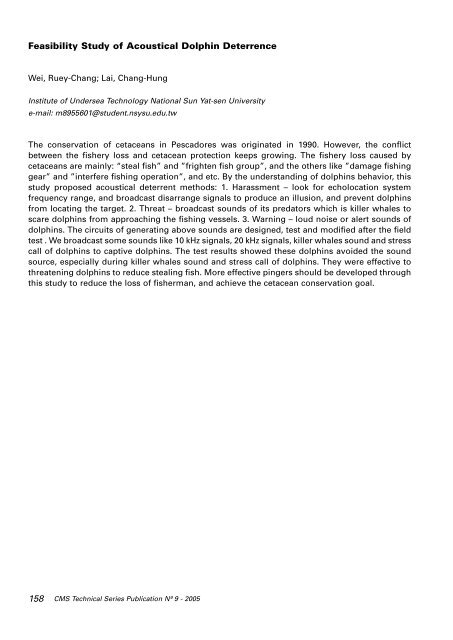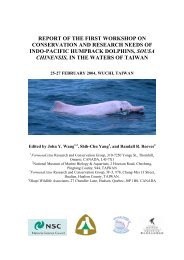Report of the Second Workshop on The Biology and Conservation of ...
Report of the Second Workshop on The Biology and Conservation of ...
Report of the Second Workshop on The Biology and Conservation of ...
Create successful ePaper yourself
Turn your PDF publications into a flip-book with our unique Google optimized e-Paper software.
Feasibility Study <str<strong>on</strong>g>of</str<strong>on</strong>g> Acoustical Dolphin DeterrenceWei, Ruey-Chang; Lai, Chang-HungInstitute <str<strong>on</strong>g>of</str<strong>on</strong>g> Undersea Technology Nati<strong>on</strong>al Sun Yat-sen Universitye-mail: m8955601@student.nsysu.edu.tw<strong>The</strong> c<strong>on</strong>servati<strong>on</strong> <str<strong>on</strong>g>of</str<strong>on</strong>g> cetaceans in Pescadores was originated in 1990. However, <str<strong>on</strong>g>the</str<strong>on</strong>g> c<strong>on</strong>flictbetween <str<strong>on</strong>g>the</str<strong>on</strong>g> fishery loss <strong>and</strong> cetacean protecti<strong>on</strong> keeps growing. <strong>The</strong> fishery loss caused bycetaceans are mainly: “steal fish” <strong>and</strong> ”frighten fish group”, <strong>and</strong> <str<strong>on</strong>g>the</str<strong>on</strong>g> o<str<strong>on</strong>g>the</str<strong>on</strong>g>rs like ”damage fishinggear” <strong>and</strong> ”interfere fishing operati<strong>on</strong>”, <strong>and</strong> etc. By <str<strong>on</strong>g>the</str<strong>on</strong>g> underst<strong>and</strong>ing <str<strong>on</strong>g>of</str<strong>on</strong>g> dolphins behavior, thisstudy proposed acoustical deterrent methods: 1. Harassment – look for echolocati<strong>on</strong> systemfrequency range, <strong>and</strong> broadcast disarrange signals to produce an illusi<strong>on</strong>, <strong>and</strong> prevent dolphinsfrom locating <str<strong>on</strong>g>the</str<strong>on</strong>g> target. 2. Threat – broadcast sounds <str<strong>on</strong>g>of</str<strong>on</strong>g> its predators which is killer whales toscare dolphins from approaching <str<strong>on</strong>g>the</str<strong>on</strong>g> fishing vessels. 3. Warning – loud noise or alert sounds <str<strong>on</strong>g>of</str<strong>on</strong>g>dolphins. <strong>The</strong> circuits <str<strong>on</strong>g>of</str<strong>on</strong>g> generating above sounds are designed, test <strong>and</strong> modified after <str<strong>on</strong>g>the</str<strong>on</strong>g> fieldtest . We broadcast some sounds like 10 kHz signals, 20 kHz signals, killer whales sound <strong>and</strong> stresscall <str<strong>on</strong>g>of</str<strong>on</strong>g> dolphins to captive dolphins. <strong>The</strong> test results showed <str<strong>on</strong>g>the</str<strong>on</strong>g>se dolphins avoided <str<strong>on</strong>g>the</str<strong>on</strong>g> soundsource, especially during killer whales sound <strong>and</strong> stress call <str<strong>on</strong>g>of</str<strong>on</strong>g> dolphins. <strong>The</strong>y were effective tothreatening dolphins to reduce stealing fish. More effective pingers should be developed throughthis study to reduce <str<strong>on</strong>g>the</str<strong>on</strong>g> loss <str<strong>on</strong>g>of</str<strong>on</strong>g> fisherman, <strong>and</strong> achieve <str<strong>on</strong>g>the</str<strong>on</strong>g> cetacean c<strong>on</strong>servati<strong>on</strong> goal.158 CMS Technical Series Publicati<strong>on</strong> Nº 9 - 2005





